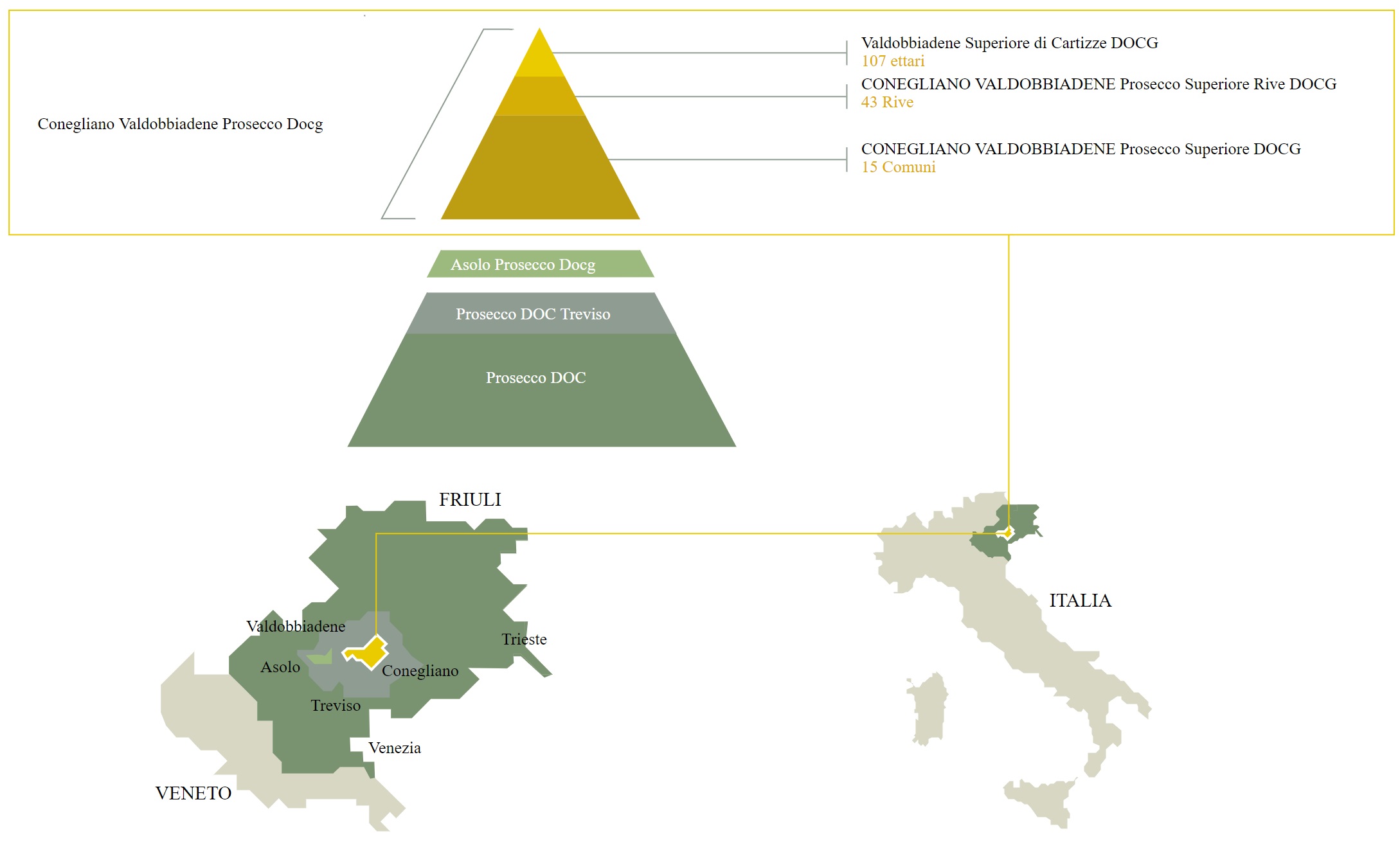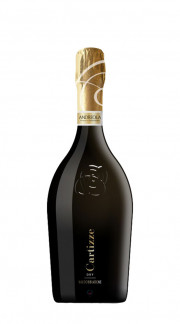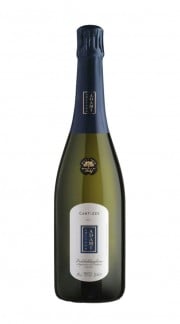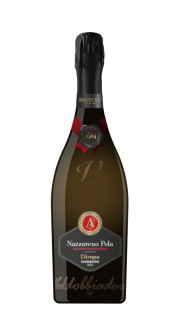It lacks to free shipping
Prosecco
It is the most produced and sold sparkling wine in the world, it even surpasses Champagne (in quantity produced). The vine used to produce it is Glera , an ancient grape of unknown origin, but which was already mentioned in the area in the 1500s. It is a fragrant, soft and easily recognizable grape. Prosecco is produced exclusively with the Charmat method which enhances its aromatic profile. It is at home throughout the Veneto, excluding the provinces of Rovigo and Verona, and in part of Friuli, but the areas with the greatest vocation, the DOCG, are in Conegliano and Valdobbiadene and on the Asolani hills. Of note is the Prosecco di Cartizze, an enclave of just over 100 hectares, still in the municipality of Valdobbiadene, known for its fine production of Glera (a real Cru), refined by a slight residual sugar which makes this sparkling wine little gem. As a small historical note, it seems that the name Prosecco derives from the municipality of the same name in the province of Trieste, where, curiously, the production of this sparkling wine actually started a very short time ago! Prosecco is a subtle, unstructured, light and fragrant wine, so it is excellent for the best aperitifs!
Prosecco is currently the best-selling sparkling wine in the world and its territory, the marvelous hills between Conegliano and Valdobbiadene, in the province of Treviso, are its cradle. These areas boast an ancient tradition linked to the cultivation of vines, the first written evidence of which dates back to the time of the Roman colonists.
HISTORY OF PROSECCO
The vocation for the production especially of white wines, in the area of Conegliano and Valdobbiadene, is testified by numerous documents such as those relating to the domination of the Venetian Republic and the testimonies for the appreciation of the "white wine of the hills of Conegliano Valdobbiadene" by the various European rulers .
In more recent times, a great boost to quality viticulture is given by the birth in 1876, in Conegliano, of the Enological School and, subsequently in 1923, of the first Experimental Station of Viticulture and Enology of the then Italian Ministry of Agriculture, still today reference site for wine research and experimentation in Italy (see CREA). With regard to Prosecco, as we know it, the activity of Antonio Carpené (1838-1902) was essential, who was the first to study the possibility of obtaining a sparkling wine through refermentation in large vats. Subsequently, the improvements implemented by his nephew Antonio Carpenè (1913-2010) were decisive, on the basis of research conducted at the end of the 19th century by Federico Martinotti, Director of the Experimental Institute for Enology of Asti and the one who conceived the famous Charmat method- Martinotti ; thanks to these advances, in 1924 the first bottle of sparkling Prosecco “Colli Trevigiani” was produced by the sparkling wine house Carpenè & Malvolti. In 1936, on the basis of the pedoclimatic analyzes (that is, relating to the soil and the climate) of the Experimental Institute (already mentioned), a first delimitation of the Prosecco production area was reached, or rather "of Conegliano and Valdobbiadene"; at this juncture, it takes its cue from French legislation, oriented towards the valorisation of individual territories. This "draft", also due to the beginning of the Second World War, would never have seen the light, but would have fueled awareness of the value of wine and of this territory. So, we come to 1962, when the most far-sighted Prosecco producers take action to form a Protection Consortium and to define the production regulations necessary to start the procedure for the recognition of the Denomination of Controlled Origin for the wine of the hills of Conegliano and Valdobbiadene . And this same foresight, also fueled by prestigious scholars such as Italo Cosmo and Giovanni Dalmasso, led in 1966 to the establishment of the Prosecco and Wines of the Hills of Conegliano and Valdobbiadene Road , the first example in Italy.
PROSECCO TODAY
The direction is the right one and in fact the numbers prove absolutely right: in 1974, the bottles of Prosecco produced were 6 and a half million, today we are over 600 million bottles (data: ilSole24ore, 2021). Since those early years, the wine production system of the hills of Conegliano and Valdobbiadene has grown, as can be seen, exponentially; consequently, the production area was extended to almost all of Veneto and to all 4 provinces of Friuli Venezia Giulia. To give further evidence of the importance of the Prosecco phenomenon, in 2003 the Veneto Region, given the particular economic profile and the national importance of the Denomination, recognized its production system as an industrial district, the first case in the sparkling wine sector. And in 2009, thanks to the continuous improvement in quality and the notoriety achieved in 40 years of constant development, the Prosecco from the hills of Conegliano and Valdobbiadene was recognized by the Ministry of Agricultural and Forestry Policies with the Denomination of Controlled and Guaranteed Origin (DOCG), including therefore in the ranks of the most prestigious Italian wines. Finally, in 2019, as the icing on the cake, the hills of Conegliano and Valdobbiadene were included in the UNESCO World Heritage list, a prestigious recognition and a harbinger of a splendid future.
PROSECCO CLASSIFICATION
As we have seen, all this success means a growing demand for the product which, necessarily, provides for the expansion of the initial production borders, inevitably moving away from the area of origin. Therefore, when we speak generically of Prosecco today, it is necessary to distinguish the following 3 denominations with the related products:
1) Conegliano Valdobbiadene Prosecco DOCG and 2) Asolo Prosecco DOCG, or the 2 Controlled and Guaranteed Denominations of Origin (for the Spumante type, they can also boast the mention "Superiore"); over time, these specific areas have in fact distinguished themselves because they are able to express a wine of particular excellence, awarded with the DOCG denomination.
3) Prosecco DOC which is produced throughout Friuli Venezia Giulia and in all the provinces of Veneto, except Verona and Rovigo. To date, 80% of the Prosecco drunk in Italy and in the rest of the world is produced in Veneto, the remaining twenty in Friuli-Venezia Giulia. Prosecco DOC is the geographically most extensive Denomination in Italy.
GRAPES AND THE DIFFERENT TYPES OF PROSECCO
Prosecco comes from a specific white grape variety: Glera. The disciplinary requires that at least 85% of Glera be used to produce this wine.

For the remaining 15% it is possible to use other minor vines, chosen on the basis of the taste/olfactory result to be obtained: they are Perera, which increases aroma and perfume; Verdisio, which develops sapidity; the Bianchetta Trevigiana, which helps to refine the wine's content and the Chardonnay, Pinot Grigio and Pinot Noir (vinified in white) which are used in the production of the Spumante version only (these too in a percentage not exceeding 15%). In fact, although Prosecco is known throughout the world as Spumante, there are 2 other types that can be made, always with the same name:
1) “still” Prosecco. The adjective 'tranquillo' (or 'still'), indicates precisely the lack of bubbles; it is mainly consumed in the production area.
2) "sparkling" Prosecco, this type is produced in an autoclave (Martinotti / Charmat method), like Spumante, but using a lower overpressure than that used for Spumante. This translates into a lower presence of carbon dioxide inside (ie 'fewer bubbles') and therefore into a light and less persistent perlage.
3) Prosecco “Colfondo, i.e. with the natural sediments of the yeasts due to refermentation in the bottle. It was essentially the "historic" Prosecco before the introduction of sparkling wine.
Prosecco Spumante is distinguished, in turn, into 3 different types, which differ from each other based on the residual sugar that is added before bottling:
1) BRUT, Residual sugar: 0-12 g/lt, we will have a very dry sparkling wine.
2) EXTRA DRY, Residual sugar: 12/17 g/lt, we will have a slightly dry, rather "soft" sparkling wine.
3) DRY, Residual sugar: 17/32 g/lt, we will have a sparkling wine that is not sweet, but decidedly "soft".
THE “CRU” OF PROSECCO
As regards the areas with the highest qualitative vocation for Glera, in the DOCG areas there are two particular selections of Prosecco which, in a certain sense, can be considered the 'best of the best' of this wine, real "Cru" :
1) Prosecco Superiore "Cartizze"; its grapes grow on a single hill: just over 100 hectares near the municipality of Valdobbiadene. Difficult terrains, located on the steepest slopes of the hills of Santo Stefano, Saccol and San Pietro di Barbozza, made unique by a microclimate particularly suitable for vines and by a soil which, in the distant past, was part of the sea bed. The end result is a sparkling wine of absolute finesse and excellence, whose qualities are recognized by connoisseurs from all over the world.
2) Prosecco Superiore "Rive"; the word 'Rive' indicates the steepest slopes of the hills of Conegliano and Valdobbiadene: inaccessible places, where working is a heroic undertaking, but these are the lands in which the glera is able to express itself at its best. The particular nature of the soil, the benefits of the altitude and the enviable exposure mean that this vine produces excellent grapes, from which an absolutely inimitable wine is born. It is no coincidence that a Prosecco 'Rive', in order to be defined as such, must comply with much more stringent rules than a 'normal' Prosecco. Rules such as the harvest, which must be done strictly by hand, the maximum production quantities and the precise indication of the place of origin. Finally, it should be remembered that Prosecco 'Rive' can only exist in the Spumante version.
HOW TO MATCH PROSECCO
Prosecco is a wine with particularly fruity notes, delicate and which here requires combinations with lightly cooked foods, capable of enhancing the aromas of the wine, without predominating its taste. Also as an aperitif, it is better to serve it smooth, without adding other elements, to preserve its delicate fragrance.
Excellent with fish, crustaceans, vegetables, non-spicy cured meats; absolutely avoid pairing with desserts.


